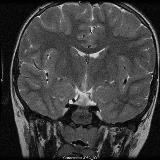TRANSCALLOSAL RESECTION OF HYPOTHALAMIC HAMARTOMA IN THE TREATMENT OF REFRACTORY EPILEPSY
Abstract number :
1.457
Submission category :
Year :
2003
Submission ID :
2165
Source :
www.aesnet.org
Presentation date :
12/6/2003 12:00:00 AM
Published date :
Dec 1, 2003, 06:00 AM
Authors :
Yu-tze Ng, John F. Kerrigan, Harold L. Rekate, Jeffrey V. Rosenfeld, Erin C. Prenger, Margaret R. Varland, Robert F. Spetzler Neuroscience, Barrow Neurological Institute, St. Joseph[apos]s Hospital and Medical Center, Phoenix, AZ; Neurosurgery, Alfred Hos
Hypothalamic hamartomas (HHs) are rare developmental malformations of the tuber cinereum that typically result in gelastic seizures followed by the development of other seizure types including tonic, tonic-clonic and complex partial. The seizures are extremely refractory to antiepileptic drugs. Previously, the resection of these HHs was thought to be either not feasible and/or would not affect the seizures of these patients. We decribe the successful resection of HHs in seven patients with resultant dramatic cessation of their seizures in four.
SURGICAL: The procedure was performed with some modifications using the transcallosal-intraforniceal approach originally described by Rosenfeld et al ([italic]Neurosurgery [/italic]2001;48:108-18). Using frameless stereotaxis, the callosotomy is made in the midline about 3 cm in length. The approach proceeds between the two leaves of the septum pellucidum without retractors placed on the columns of the fornices. At that point, the surgeon has a view of the floor of the third ventricle (hypothalalmus) and the hamartoma is resected. The MRI brain scans show pre and post-operative images respectively in one of the patients. [figure1] [figure2]NEUROLOGICAL: The baseline seizure types and frequencies were recorded pre and post-operatively. Other changes and/or complications were also recorded.
The seven patients were followed up for an average of 8.9 weeks. Their average age was 7.9 years and consisted of five males. Pre-operatively, all patients had multiple daily seizures. Four patients are currently seizure-free and three patients have had [gt]90% reduction in seizure frequency. Most patients had a mild, transient, post-operative hyponatremia; one patient had hyperphagia and another decreased short-term memory who are both improving. [table1]
Transcallosal resection of HH is safe and the best treatment for refractory (to medical therapies), mixed seizures that typifies these patients.
[Supported by: Nil]

